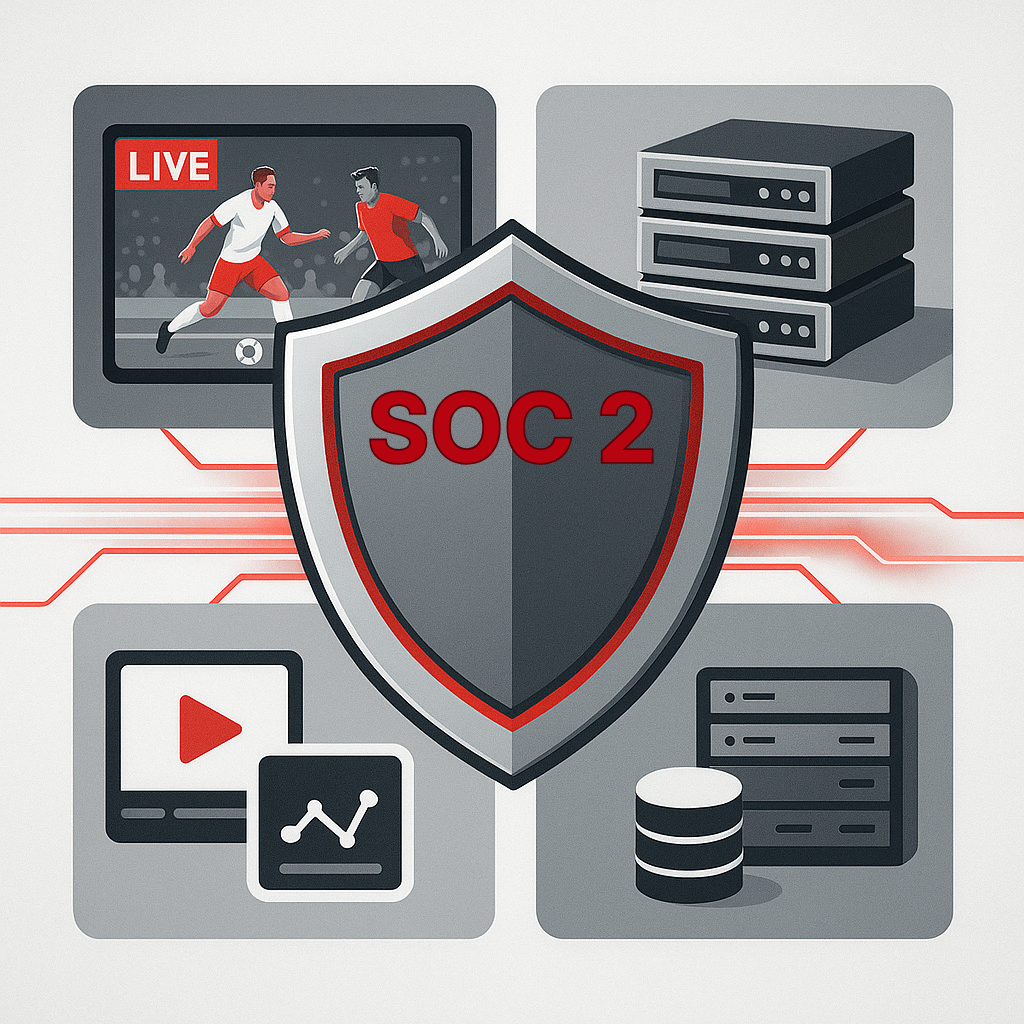In live sports video, uptime means everything. This blog explores SOC 2 Availability controls designed for startups handling real-time streaming, analytics, and broadcast feeds ensuring resilience, reliability, and trust.

In the electrifying world of sports video processing where startups deliver live streams, real-time highlights, and analytics overlays like player stats or augmented replays downtime is not an option.
Fans expect uninterrupted access, and clients demand reliability.
SOC 2, developed by the AICPA, evaluates how organizations manage customer data across five Trust Services Criteria, with Availability being critical for ensuring systems remain operational, especially during high-stakes live sports events.
For sports video startups, Availability controls are essential to prevent outages, handle traffic surges, and maintain trust with broadcasters, leagues, and viewers.
This blog explores how to design robust Availability controls tailored to the unique demands of sports video processing ensuring your pipelines stay online when it matters most.
The Availability criterion in SOC 2 ensures systems are accessible, resilient, and reliable, meeting client expectations and SLAs.
For sports video startups, prioritizing Availability delivers key benefits:
* Maintain Viewer Trust: Uninterrupted live streams and analytics keep fans engaged, avoiding reputational damage during crucial game moments.
* Meet Client SLAs: Broadcasters and leagues expect high uptime; SOC 2 Availability shows you can deliver reliable services.
* Handle Industry Demands: Sports video involves burst loads, real-time processing, and global distribution all requiring resilient infrastructure.
* Support Growth: Robust Availability controls enable scalability, ensuring performance as your audience expands.
Including Availability in your SOC 2 scope is vital if your startup provides live streaming, real-time analytics, or other time-sensitive services complementing the mandatory Security criterion.
Sports video startups face unique risks that make Availability controls indispensable.
These risks, rooted in the high-pressure nature of live sports, include:
* High-Volume, Real-Time Pipelines: Processing multiple feeds in real time demands low latency and high uptime.
* Streaming Infrastructure Outages: CDNs or streaming servers can overload or misconfigure, risking viewer access.
* Burst Loads from Major Events: Traffic surges during championships require elastic scaling to sustain performance.
* Large-Scale Storage Needs: Reliable retrieval from cloud storage (e.g., AWS S3) supports replays and archival footage.
* Analytics Pipeline Dependencies: ML-driven overlays and highlights rely on consistent processing.
* Third-Party Integration Risks: Partner feeds and cloud providers introduce potential single points of failure.
* Real-Time Operational Demands: Live events demand instant delivery; downtime is immediately visible.
* Data Retention and Recovery: Weak backup or recovery plans can delay footage access or violate SLAs.
SOC 2 Availability controls help address these risks, ensuring your systems remain operational, reliable, and trusted.
To achieve SOC 2 Availability compliance, sports video startups should implement the following controls, tailored to their real-time, high-stakes environments:
* Deploy real-time monitoring for pipeline health tracking latency, error rates, and uptime.
* Set up alerting systems (e.g., PagerDuty, Datadog) for instant notifications on stream issues or ingest failures.
* Define clear SLAs with clients, specifying uptime guarantees (e.g., 99.9%) for critical services.
* Conduct capacity forecasting using event schedules and historical viewership trends.
* Implement autoscaling for compute and storage (e.g., AWS EC2, S3) to handle peak traffic automatically.
* Perform stress testing to simulate playoff-level viewership and validate performance under pressure.
* Use multi-region deployments for storage and streaming to maintain uptime if one region fails.
* Configure failover servers and load balancers for seamless rerouting during outages.
* Design fallback logic for critical components (e.g., backup ingest pipelines) to sustain service continuity.
* Maintain versioned backups of video files and metadata with defined retention (e.g., 30–90 days).
* Regularly test restore procedures to ensure quick data recovery after incidents.
* Apply lifecycle management to optimize storage costs while preserving Availability.
* Develop a recovery plan with clear roles, escalation paths, and outage procedures.
* Conduct post-mortem reviews to identify root causes and strengthen future controls.
* Use graceful degradation to maintain partial service (e.g., lower-res streams) during failures.
* Build live dashboards visualizing pipeline health latency, throughput, and error rates.
* Integrate automated alerting for anomalies, like sudden drops in quality or analytics delays.
* Enable teams to respond proactively, minimizing service impact during live events.
These controls, grounded in SOC 2 Availability requirements, ensure your sports video pipelines remain resilient, responsive, and reliable, even during the most demanding broadcasts.
At Canadian Cyber, we specialize in helping sports video startups achieve SOC 2 Availability compliance keeping your live streams, analytics, and platforms online when it counts most.
Our team helps you:
* Design real-time monitoring and alerting systems
* Build autoscaling and redundancy strategies
* Develop incident recovery and failover plans
* Conduct gap assessments and audit preparation
We help your startup stay compliant, scalable, and always online even under the world’s biggest spotlights.
Don’t let downtime interrupt your game. Strengthen your infrastructure and guarantee SOC 2-certified Availability with Canadian Cyber.
👉 Contact us today to get started with tailored consulting for your video pipeline.
Stay connected and explore more cybersecurity insights from Canadian Cyber:
🔗 LinkedIn | 🎥 YouTube | 🎯 TikTok | 📸 Instagram | 📘 Facebook